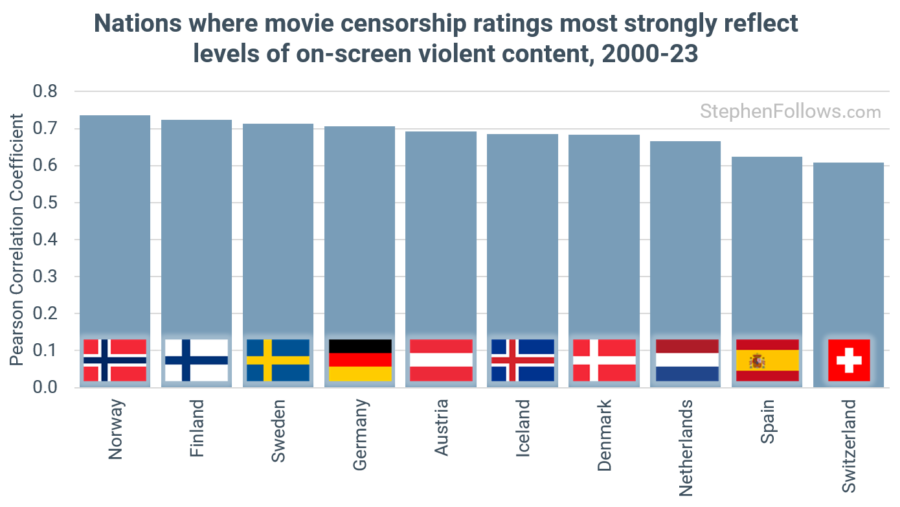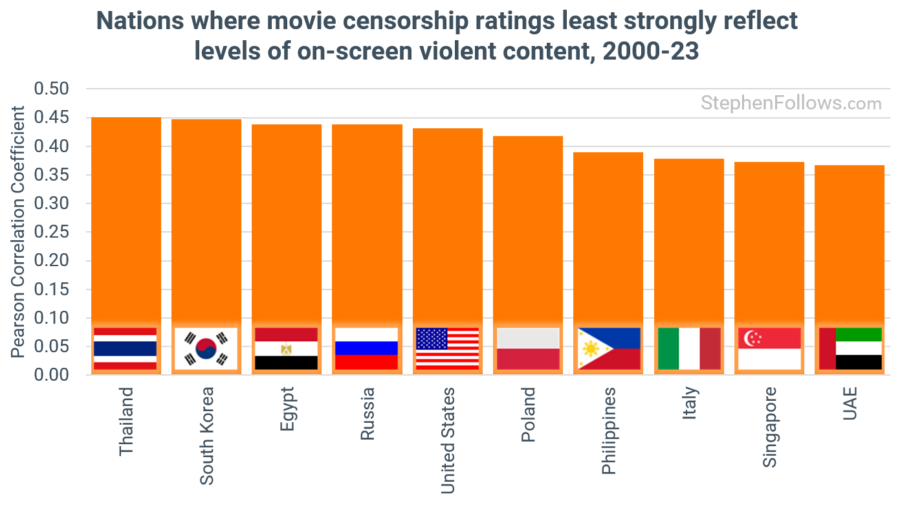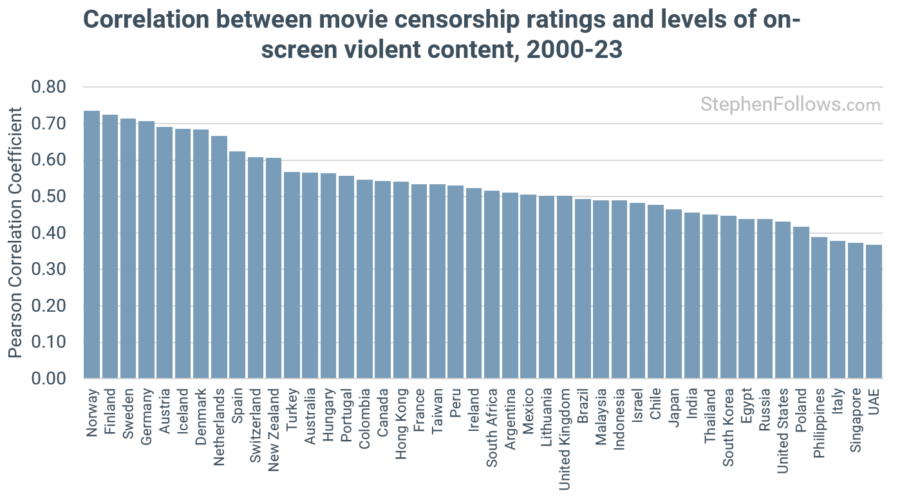Which countries care most about violence in movies?
I have previously looked at how censorship bodies around the world deal with sexual content in movies. This prompted a few readers to get in touch and ask about other aspects of possibly objectionable content.
Well, I’m glad you asked as I was also wondering. So I decided to take a look.
I analysed almost 6,000 films released worldwide since 2000. Using data from 44 different countries’ rating bodies, I assigned each film a value based on its severity rating. I then examined the Pearson correlation between these ratings and the level of violent content in each film. This allowed me to see which countries are most consistent in rating films higher when they contain significant levels of violence.
The countries most concerned about violence
Norway stands out as the nation most concerned with violent content in films. With a Pearson correlation coefficient of 0.74, the Norwegian Media Authority (Medietilsynet) shows a strong tendency to rate films more severely when they contain high levels of violence.
Norway is not alone among Nordic countries in its sensitivity to violence. Finland (0.72), Sweden (0.71), and Denmark (0.68) also show high correlations, indicating a regional pattern. The shared cultural and social frameworks among these countries could explain their similar approaches to media censorship.
The nationals least bothered by on-screen violence
At the other end of the spectrum, the United Arab Emirates shows the least correlation between film ratings and violent content, with a Pearson coefficient of 0.37.
Singapore (0.37) and Italy (0.38) also exhibit a similarly low correlation. This looser stance suggests a more permissive approach to media consumption, possibly reflecting cultural differences in how violence is perceived and the role it plays in storytelling.
A world of on-screen violence
If we zoom out to look at all 44 bodies I studied, we can see distinct regional trends. Nordic countries like Norway, Finland, and Sweden exhibit high correlations, indicating a stringent approach to rating violent films. This suggests a cultural preference for shielding audiences, especially younger viewers, from violent content.
On the other end, the UAE, Singapore, and Italy show much lower correlations. These countries appear to adopt more lenient standards, potentially reflecting a cultural acceptance of violent content in films or a different regulatory focus.
Middle-ground countries such as the United Kingdom (0.50) and Canada (0.54) strike a balance, suggesting they adopt a more nuanced approach that takes into account both audience protection and artistic freedom.
Notes
Today’s research examined 5,918 feature films released between 2000 and 2023. I collected ratings for each film from 44 different countries, ensuring that each country had at least 1,000 ratings in the dataset.
Next, I assigned a value to each rating, with the most open rating (typically “Universal” or “General”) getting a one and increasing as the ratings got stronger (for example, in the UK, an 18 certificate equated to a value of five). This then allowed me to calculate the Pearson coefficient to measure the correlation between the rating level and the amount of violent content.
The raw data from various sources, including each of the censorship bodies, OMDb, IMDb, Wikipedia, Common Sense Media, Dove.org, MPAA, and BBFC. I used these signals to build my own measures of violent content in each movie.
It’s worth noting that films may have different versions around the world. The measures of violence I tracked were based on the version released in the UK and US (which rarely differ), whereas in some territories, particular shots or moments may be trimmed or removed. That said, I don’t think it’s a massive problem in this case, as we’re looking at a large number of films and tracking how the two sets of data are correlated. So even if a movie had a particularly violent moment removed, the overall level of violent content is still lightly to be high. There are very few cases of films with a huge amount of violence being completely neutered for an international release, and even then, these kinds of rare outliers will not affect the overall result much, if at all.
The post Which countries care most about violence in movies? appeared first on Stephen Follows.






Interesting, since my getting here encompassed a perceived thought that the US would've been ranked 1st as the UAE did on the last graph. Actually that notion was more a tuned to feeling that Americans feel braver and stronger because of their overall depiction as winners in every single film scenario produced. My view of a national farce of strength, unity, bravery and America/ Americans being a Marvel hero is more to where my thoughts suggested a political brainwashing of psychology.